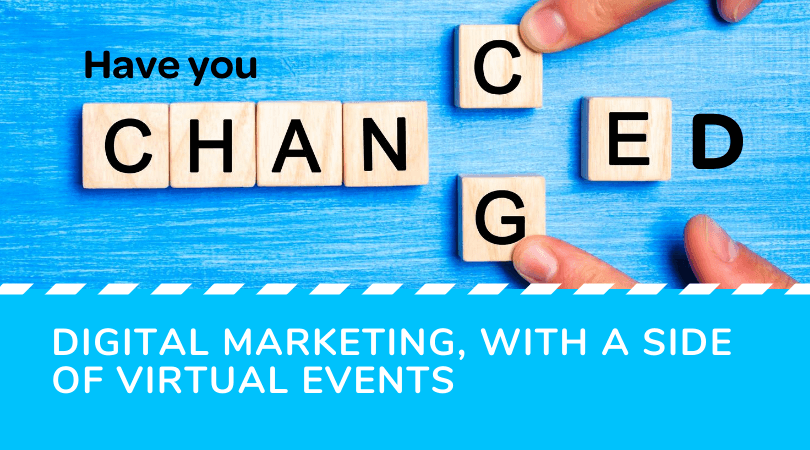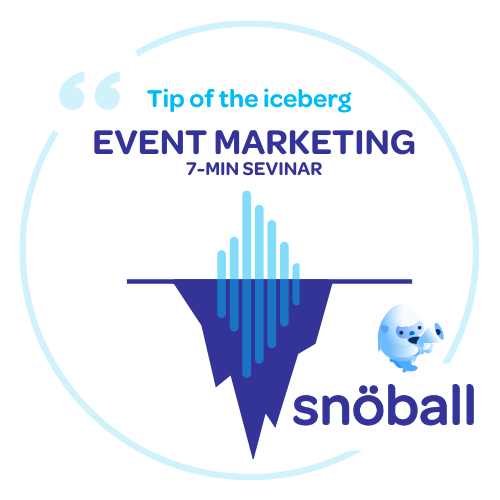Different delivery, different expectations, different experiences. We’re all intimately familiar with the difference between virtual and in-person events. But, what about when it comes to marketing your virtual event – are the same tried and true strategies that event marketers use for in-person events effective for virtual events too?
The answer may surprise you! Virtual event marketing operates with the same nuts and bolts as in-person. Adapting your event marketing to a virtual setting doesn’t require a major marketing overhaul. Your digital channels can be just as effective as ever, provided your message is tailored to a virtual event experience.
But, your message needs to adapt to your event delivery. Your marketing promotions will struggle if you don’t account for the specific pain points that your event both presents and eliminates. Let’s explore virtual events at a high level and identify the opportunities for event marketers.
Expand your segments
Identify the ‘Why’ for your organization – why is this event happening and what does it do for you? Before you can start marketing, you need to know what your organization expects to get from the event. It might be lead volume, revenue generation, market education, or sales acceleration – whatever it may be, event marketers need to know.
To effectively promote an event, event marketers should identify the audience they need to target. If we’re looking to accelerate sales through an organization’s funnel, we need to segment people that are already engaging with your company. If you want to educate your audience, you need people within your topic’s field. It’s all about getting your content in front of the right audience so that they take the right action.
But for virtual events, event marketers should cast a wider net than usual. This is an excellent opportunity to both accelerate existing opportunities and acquire new prospects. Your virtual event is an easier conversion point than an in-person event and the post-show data allows for extremely targeted follow-up delivery. Segment according to industry and interest, but keep your content broad enough to capture different job duties and industry professionals. You can use the data from your virtual event to create more detailed segments during your follow-up activities.
Paid vs. free virtual event marketing
Depending on if your virtual event is paid or free, there are different elements you should emphasize during promotion. Each presents a different value proposition and, for paid virtual events in particular, it’s critical to emphasize what attendees will take away from the event.
For free virtual events, promotion will typically focus around the event itself – the sessions, the speakers, and the overall experience. Marketing materials will reflect the participants who are joining and push the FOMO using the attendee networks.
However, for paid virtual events, promotion needs to focus on actionable takeaways. When we pay for something, we expect a certain level of tangible value. At in-person events, it’s easy to see that value in things like venue space, stage design, and dining options. But for virtual events, the value is isolated to the core purpose of the event. Emphasizing this value is critical to convert paid attendees.
Things like certification credits, networking, and engagement opportunities or live-only education create exclusivity around a paid event, in addition to delivering real value for attendees after the stream closes. When promoting a paid virtual event, hammer down on the tangible value as much as possible.
Strengthen the core
Your virtual event does something exceptionally well. Maybe it’s your delivery, maybe it’s your content, maybe it’s the audience engagement – it could be any number of things. Find that thing.
Successful virtual event marketing comes from identifying the best parts of your event and promoting the heck out of them. Going back to promoting paid events, you want to promote the best pieces – the parts with the most value. Once you’ve found where your virtual event is awesome, build your marketing materials around that piece (or pieces)!
If your event has a great education track, your marketing materials should reflect the value of that education. Emphasize your speakers and experts to increase educational credibility or play up the exclusivity of the content.
If your event has a fantastic post-show experience, promote that! One of the biggest values for virtual events is the ability to access them over and over. Help registrants understand that all content will be available for them, even if they miss the live virtual sessions. It’s all about finding where your event can shine and polishing it until it sparkles.
“If you want your event experience to stand out, you need to figure out how to entice your audience. You have to figure out what are the top things that you are offering – that’s your call to action!” – Dahlia El Gazzar, Dahlia Plus Agency
Understand your value
Virtual events have an entirely different value proposition than their in-person counterparts. Understanding how that value proposition differs is another way to significantly improve your virtual event marketing strategies.
First, don’t oversell yourself. Your virtual event will be great, but it isn’t going to replicate a trade show floor. You don’t want attendees to show up just to be disappointed. If your marketing materials create expectations that your event doesn’t meet, you’re going to be in for a rude awakening during your next promotional cycle.
That being said, don’t undersell yourself either! Virtual events are great because they’re…wait for it….VIRTUAL! They empower previously untouched event audiences to experience something new. Introverts and travel-restricted individuals are the perfect addition to your audience. Your marketing should reflect that!
“Nothing will be more impactful than marketing that hits a pain point and speaks to something your audience is really going through.” – Rachel Stephan, snöball
Accessibility is the single biggest pain point for in-person events. They require travel, commitment, and investment – all barriers to entry. Scratch all of that when we go virtual. Content is available from almost anywhere, at almost any time. Doesn’t that seem like a major sell point for the casual registrant?
3 strategies to market your virtual event
So, we’ve talked about the value opportunities for your virtual event, but how do you communicate that value effectively? Here are three strategies you can take to the virtual bank:
- Create your event’s story: All good marketing tells a story. And not just any story, your story. The first thing your event marketing team should do when promoting a virtual event is to brainstorm the biggest values, most exciting elements, and most impactful messages. Once you’ve identified your biggest sell points, craft your story. This is what each and every message will tie back to – it acts as our marketing foundation. Examples:
- Value: certifications, networking access, education, event replacement
- Exciting elements: interactivity, live to virtual audience communication, major speaker(s)
- Impactful messages: industry collaboration, grassroots missions, ties to a cause
- Optimize your conversion points: Anywhere you’re capturing new attendees should be conversion optimized. Start with your website – does it speak to your audience? Does the messaging reflect your event and its story? If the answer is yes, then consider where your prospective attendees can register. There should be a conversion point visible on your site at all times, with sections designed to drive content to specific segments. Each person visiting your site isn’t the same – make sure there is conversion-optimized content for all of your identified segments.
Repeat this process across all digital channels. Pin conversion-based social media posts, optimize any and all landing pages, review your email copy and design. Each and every point of communication can become a point of conversion if designed properly.
. - Tap into your influencers: The easiest way to expand your audience is through your audience. Your speakers and sponsors are partners for your event. Make sure your marketing materials promote major speakers; use their industry credibility to improve your virtual event’s credibility. But don’t limit yourself to just the biggest names – each and every attendee can be an influencer for you too! Your micro-influencers have their own networks, which are hyper-targeted to their specific interests. Create a digital marketing toolkit that is easily shared on social media and through email to give your attendees a quick, simple marketing opportunity on your behalf.
“You want to make sure you’re authentic, make sure you tailor your story to your audience. Speak to them in a language that appeals to them.” – Ramie Merriman, Hubb
Bottom Line
Virtual event marketing is powered by the same tools as live event marketing. The channels and distribution points to spread a marketing message are the same as ever. But, the value and the story behind virtual events are brand new. To successfully market your virtual event, event marketers need to understand how their event presents value and emphasize those areas.
We can’t make virtual events perfect, but we can perfect their marketing. Stick to your strengths, attack the proper segments, and understand the value behind your event.
To unlock the full potential of your virtual event’s influencers, give snöball a try. Our event influencer marketing platform was purpose-built to empower your event’s participants at scale with the marketing tools they need to promote their participation at your event, complete with incentivization capabilities and analytics.
Now, go forth, and market your virtual events!


